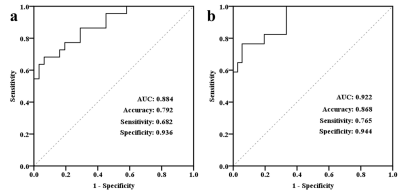1Radiology, Zhongda Hospital, School of Medicine, Southeast University, Nanjing, China, 2Philips Healthcare, Greater China, Shanghai, China

A 43ys patient presenting with SSNHL and tinnitus of the left ear for 7 days. The PTA was 80 dB. 3D-FLAIR images was scanned 3 days later, showed that SIs of the left cochlea and vestibule were slightly higher than those of the right with markedly delayed enhancement after contrast. Other sequences showed no abnormality. This case was diagnosed as unilateral SSNHL due to labyrinthine inflammation combined with blood labyrinth barrier disruption. The patient was hospitalized and received a comprehensive therapeutic protocol for 9 days, the curative effect was ineffective as expected.

ROC curves of the two primary clinical-image prognosis assessment models for unilateral SSNHL.
Fig a. Model used for no hearing recovery with a moderate prediction value. It included six prognostic factors: age ≥ 50 years, simultaneously abnormal DPOAE and TEOAE, longer period from onset to clinical examination, PTA at onset, severe to profound initial hearing loss, and positive MR inner ear findings. Fig b. Model used for complete hearing recovery with a high prediction value. It consisted of two prognostic factors: PTA at onset and the period from onset to MR examination.